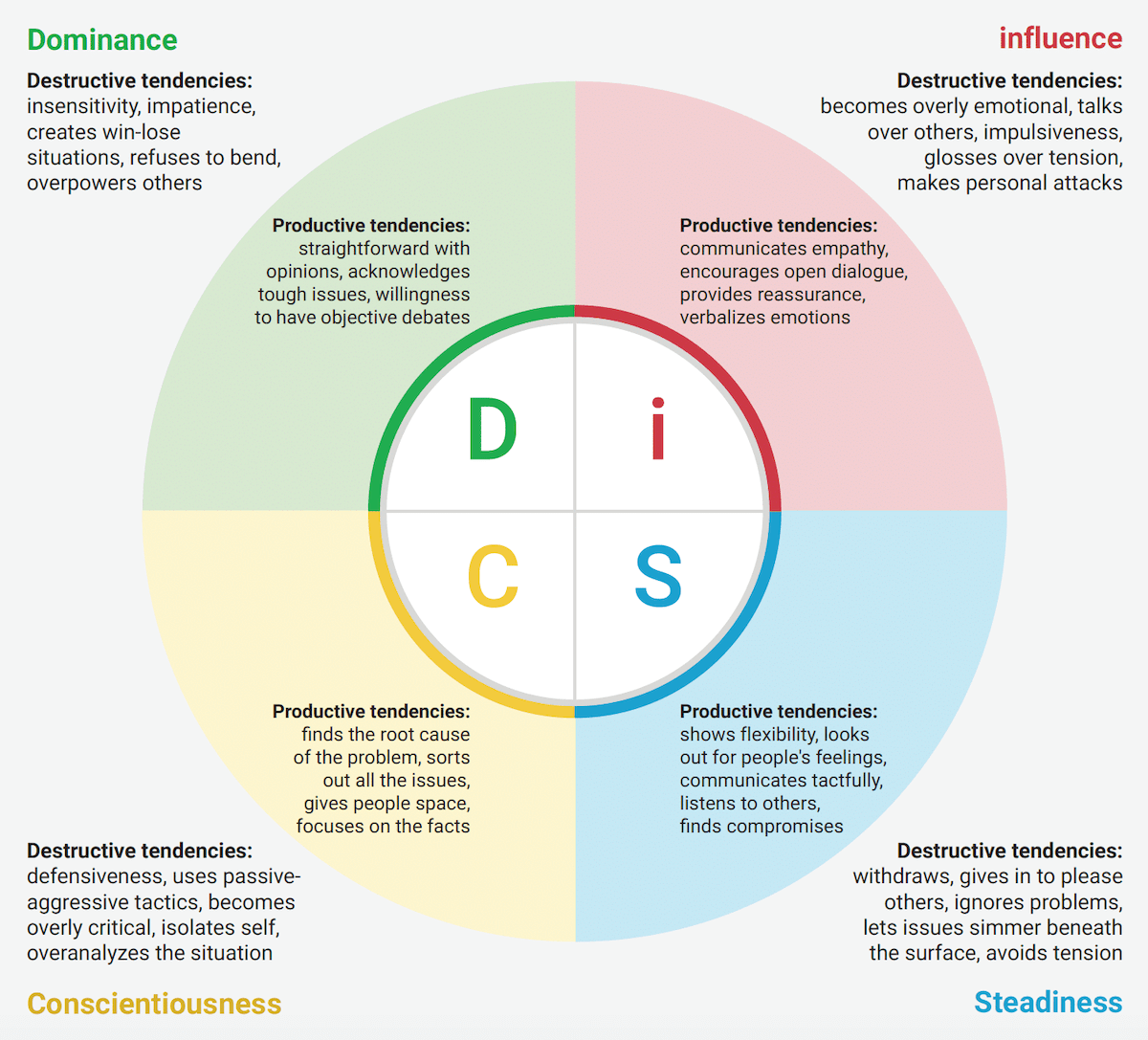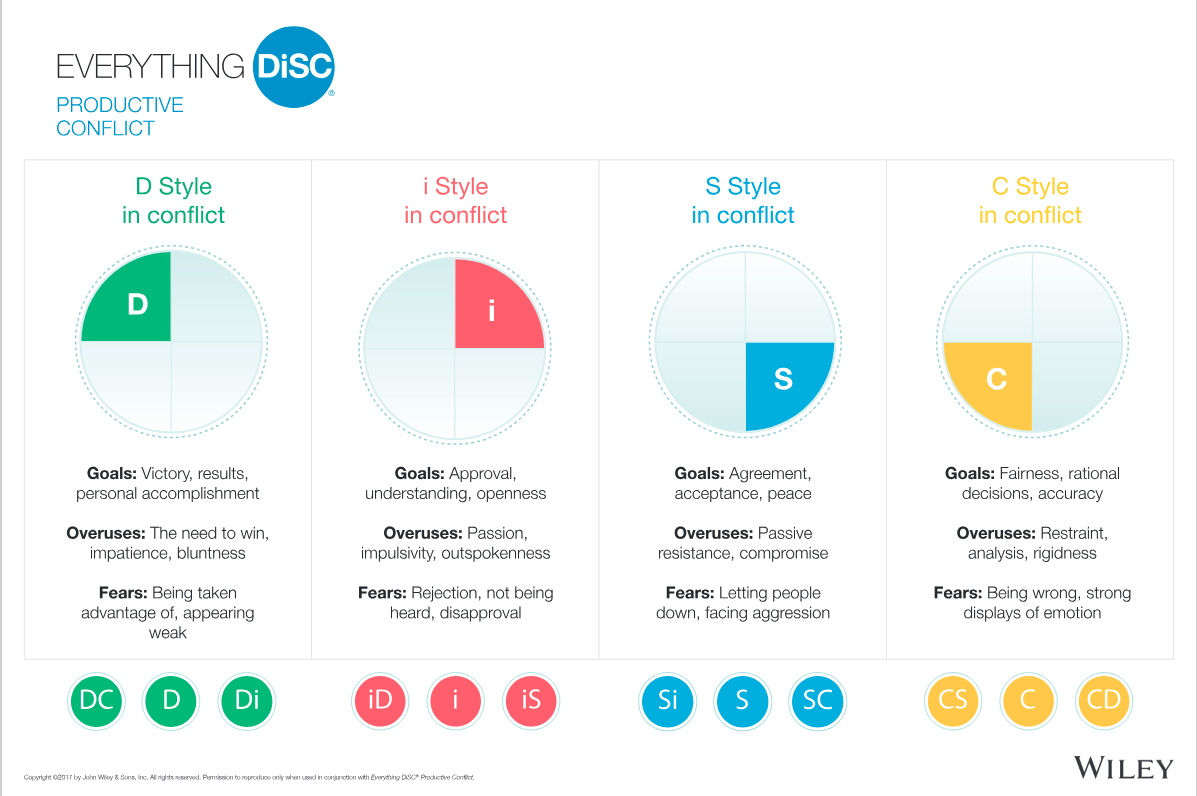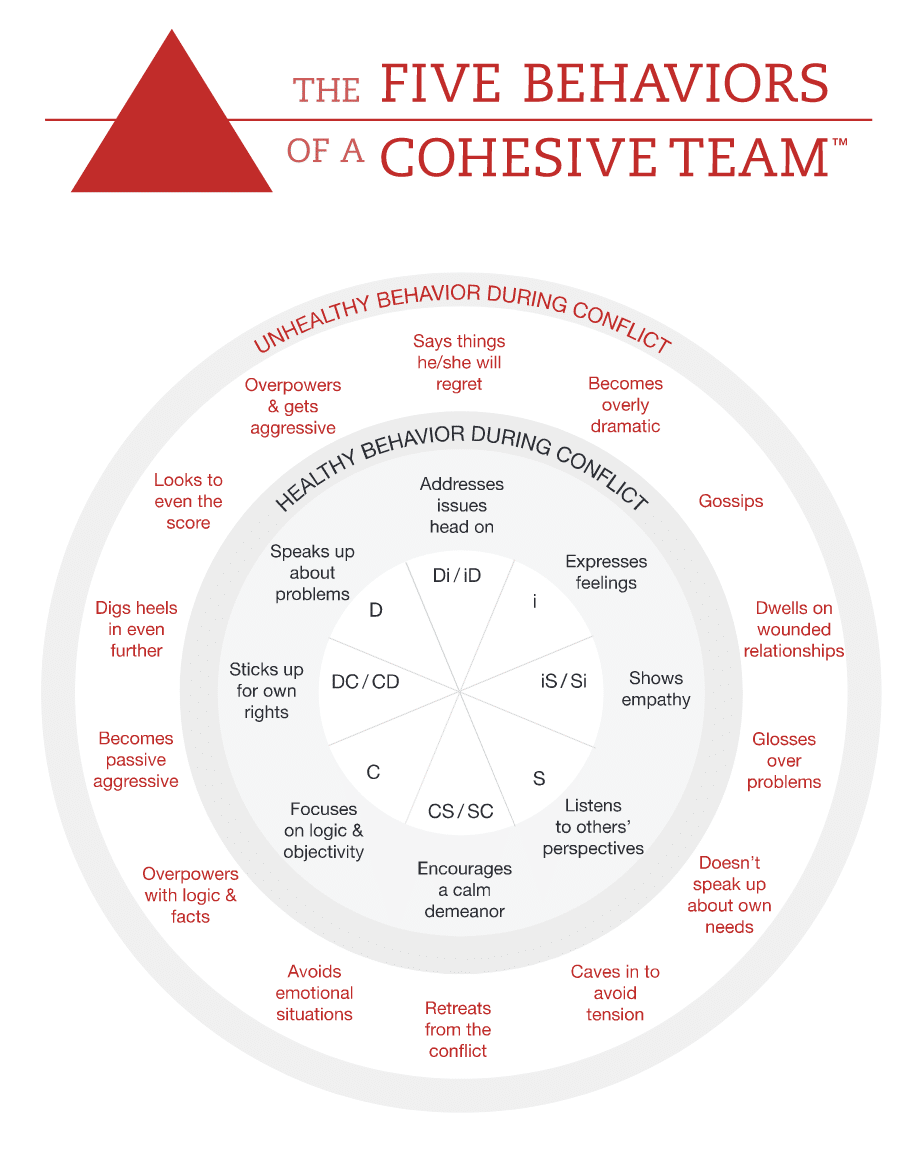DiSC Styles and Conflict Management

Key Takeaways
- D-style people assert during conflict. They confront issues directly, but can get too focused on winning.
- i-style people express during conflict. They verbalize their emotions well, but can resort to personal attacks.
- S-style people harmonize during conflict. They are good at finding common ground, but give in to please others.
- C-style people defend during conflict. They have the tenacity to stick with an issue until they find the root problem, but can overuse passive-aggressive tactics.
Conflict can lead to innovation, deeper relationships, and better problem-solving. It can also create a toxic work environment, erode trust, and bring projects to a standstill.
Many people see only the negative side of conflict. Thus, they spend a lot of energy trying to avoid it, both at work and outside it. A more effective choice is to minimize unhealthy conflict while encouraging healthy conflict. Or, ideally, to transform destructive conflict into productive conflict.
What does conflict mean?
Conflict is a difference of opinions involving strong emotions, according to Everything DiSC® Productive Conflict. It can be a brief event or a long-lasting undercurrent. Conflict may take the form of arguing or gossiping—or finding solutions and taking ownership. Conflict can be uncomfortable, but it is a natural part of human relationships.
A person's relationship with conflict stems from many factors. Conflict habits form early depending on the amount and type of conflict experienced at home. In addition, regional and cultural norms shape how we react to disagreements or tense situations.
Personality type also plays a role. Some personality types seek out conflict, while others will do almost anything to avoid it. All personality types have natural talents and drawbacks when in conflict situations.

DiSC profiles in conflict
We'll provide more detail below, but here is a summary of how the four main DiSC styles deal with conflict:
- D-style people tend to be assertive and direct. In conflict situations, they confront issues head-on and seek quick resolutions. However, their straightforward approach can sometimes come off as aggressive, which may escalate tensions. To manage conflicts with D-style individuals, be candid and focus on solutions.
- People with i styles are often enthusiastic and people-oriented. In conflicts, they prioritize maintaining relationships over addressing the issue at hand. They might avoid confrontation or try to lighten the mood with humor. To engage in conflict with i-type folks, acknowledge their feelings and ensure they feel heard.
- S-type individuals are typically calm and supportive. In conflict situations, they may seek to mediate and find common ground, often avoiding direct confrontation. However, their desire for harmony can lead to unresolved issues. In conflict with S styles, create a safe space for them to express their thoughts and feelings without pressure.
- Those with C styles are detail-oriented and analytical. In conflicts, they may focus on facts and data, sometimes appearing detached or overly critical. They prefer to resolve issues through logical reasoning rather than emotional discussions. During conflict, present C-style people with structured arguments and be respectful of their need for thoroughness.
Every personality type has natural tendencies that are useful in conflict, and those that aren't. To make conflict more productive using the DiSC model,
- Understand your own instincts around conflict.
- Embrace your tendencies when they're helpful.
- Learn how to manage the less-helpful instincts.
- Understand about how other styles show up in conflict situations.
- Adapt your approach to conflict with different people.

D styles assert
During conflict, people with D styles are looking for ways to control the situation. They assert themselves and justify their point of view. D types focus more on “winning” the conflict than other styles do.
People with D styles prefer to say what they mean, rather than tiptoeing around sensitive topics. They can be skeptical or suspicious of others' motives.
In the Everything DiSC Productive Conflict map, you can see the D-style priorities of control, justification, and assertion.

Our reactions to conflict often grow out of our fears. People with D styles are afraid of appearing weak. They need to ensure no one takes advantage of them.
D-style instincts during conflict:
- establishing control
- being direct
- winning
What drains D-style people's energy during conflict:
- feeling they have to censor themselves
- circular arguments
- trying to hide their skepticism
- dealing with people who aren't straightforward
- being wrong
Healthy behaviors of D styles during conflict:
- straightforward with opinions
- acknowledge tough issues
- willing to have objective debates
- speak up about problems (D)
- stick up for own rights (DC)
- address issues head on (Di)
Unhealthy behaviors of D styles during conflict:
- bluntness or insensitivity
- impatience
- create win-lose situations
- refuse to bend
- overpower others
- look to even the score (D, DC)
- dig heels in even further (DC)
- overpower and get aggressive (D, Di)
- say things they will regret (Di)
Managing conflict with a D-style person:
- Don't get pulled into a power struggle. However, do be ready to stand up for yourself. If you have a more accommodating personality type, your instinct might be to step back when they get aggressive. Practice using assertive language. Don't over-apologize.
- Address issues right away. Acknowledge problems instead of hoping they go away.
- Be direct. And don't take their directness as a personal attack.
- Make sure the resolution includes your input and needs.
i styles express
People with i styles prioritize expression, assertion, and reassurance during conflict. They are the most feelings-focused style. Their willingness to articulate their emotions often encourages others to open up.

i-style individuals probably prefer to avoid direct conflict. They may use their charisma and social skills to steer away from uncomfortable topics.
Conflict stokes these i-style fears: that they will be rejected, that people will disapprove of them, and that they will not be heard.
i-style instincts during conflict:
- verbalizing feelings
- seeking support from others
- expressing and engaging with emotions
What drains i-style people's energy during conflict:
- feeling misunderstood
- negativity, or when people are only pointing out problems
- dealing with people who aren't showing empathy
- having to be stern or give unpleasant feedback
- not knowing what people are keeping to themselves
Healthy behaviors of i styles during conflict:
- communicate empathy
- encourage open dialogue
- provide reassurance
- express feelings (i)
- address issues head on (iD)
- show empathy (iS)
Unhealthy behaviors of i styles during conflict:
- become overly emotional
- talk over others
- are impulsive
- gloss over tension
- make personal attacks
- gossip (i)
- say things they will regret (iD)
- become overly dramatic (i, iD)
- dwell on wounded relationships (i, iS)
Managing conflict with an i-style person:
- Allow them to express their feelings. Let them vent for a while before steering the conversation toward solutions.
- Use storytelling or emotional appeals to demonstrate your viewpoint. i-type people often respond more strongly to narratives than analytics.
- Reassure your i-style colleague that your relationship with them is still strong even though you're in conflict right now. If things get heated, take a break. When possible, try to end debates on a friendly note.
- Realize you may have to speak up for your opinions. People with i styles may interrupt or talk over you in their enthusiasm. Figure out how all people involved can have their voices heard.

S styles harmonize
DiSC S-style people prioritize harmony, stability, and reassurance during conflict. They are able to encourage a calm demeanor among the group and support people when things get tense.

Because conflict threatens the stable environment they prefer, people with S-styles tend to avoid conflict whenever possible. When things heat up, they may recede or shut off.
Conflict engages these fears of S-style folks: letting people down and facing aggression.
S-style instincts during conflict:
- keeping the peace
- minimizing uncomfortable feelings
- withdrawing and avoiding
What drains S-style people's energy during conflict:
- dealing with angry people
- having to speak before they have time to think
- having to be forceful or insist on being heard
- feeling they need to take sides
- chaos or tension that makes outcomes unpredictable
Healthy behaviors of S styles during conflict:
- show flexibility
- look out for people's feelings
- communicate tactfully
- give people the benefit of the doubt
- look for common ground or compromise
- draw out and listen to others' perspectives
- show empathy (Si)
- encourage a calm demeanor (SC)
Unhealthy behaviors of S styles during conflict:
- withdraw
- give in to please others
- let issues simmer
- avoid tension
- reluctant to express true feelings
- don't speak up about their own needs (S)
- gloss over problems (S, Si)
- dwell on wounded relationships (Si)
- cave in to avoid tension (S, SC)
- retreat from the conflict (SC)
Managing conflict with an S-style person:
- Watch them for signs of stress. They may not speak up if you have offended them or if they have a counter-argument. The signs of tension in an S style are often more subtle.
- Encourage them to share their views.
- Don't overpower them. Don't take advantage of their accommodating nature to dominate the discussion.
- Lay out your argument step-by-step and give them time to process.
C styles defend
DiSC C styles in conflict focus on justice and logic. Their priorities are objectivity, stability, and justification. They're good at sticking with a problem until all the issues are sorted out.

If conflict becomes uncomfortable, C styles may withdraw. At times, the C-style tendency is to yield to others just to make the conflict end, but then hold on to their resentment.
When in conflict, C-style often confront their core fears of being wrong and strong displays of emotion.
C-style instincts during conflict:
- justifying their position
- gathering evidence
- stonewalling
What drains C-style people's energy during conflict:
- weak ideas gaining traction through emotional appeal rather than common sense
- people challenging their competence
- strong emotional displays
- having to respond to changes on the spot
- sloppy reasoning or illogical arguments
Healthy behaviors of C styles during conflict:
- find the root cause of problems
- sort out all the issues
- give people space
- focus on facts, logic, and objectivity
- stick up for own rights (CD)
- encourage a calm demeanor (CS)
Unhealthy behaviors of C styles during conflict:
- get defensive
- become overly critical
- isolate
- overanalyze the situation
- overpower with logic and facts (C)
- avoid emotional situations (C, CS)
- retreat from the conflict (CS)
- become passive aggressive (C, CD)
- dig heels in even further (CD)
Managing conflict with a C-style person:
- Look for the root cause of the problem. It may take some excavating, since C styles can choose to be indirect in conflict. Take time to listen to their perspective and the argument they lay out.
- Give them time and space to consider your position and their own. Don't insist on an immediate resolution. Don't rush to fill silences.
- Keep volatility to a minimum.
- Emphasize facts over opinions.
- Address signs of frustration, passive aggression, or silent resistance. Approach them tactfully and give them a chance to express what underlies the frustrations.

Using DiSC to manage conflict
There are many effective ways to use DiSC for conflict resolution.
Everything DiSC® Productive Conflict helps participants improve self-awareness around conflict behaviors. Rather than focus on a step-by-step process for conflict resolution, the tool teaches techniques for when conflicts arise.
The Five Behaviors® Team Development uses the power of DiSC to build cohesive teams. Conflict is one of the five behaviors, and the tool trains team members to respond to conflict in healthy ways.
Conflict management strategies feature throughout the Everything DiSC® on Catalyst™ experience. Within the Catalyst platform, Everything DiSC® Worksmart teaches managers how to navigate conflicts among team members.
If you're not sure which DiSC assessment is best for your team, give us a call to talk through the options.
Read this next: How to Handle Conflict at Work
Posted 05/15/2025








